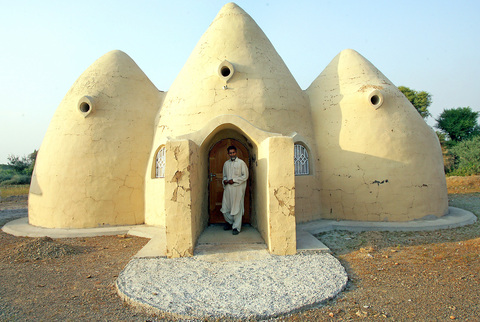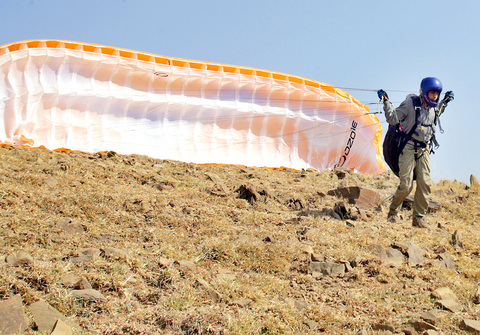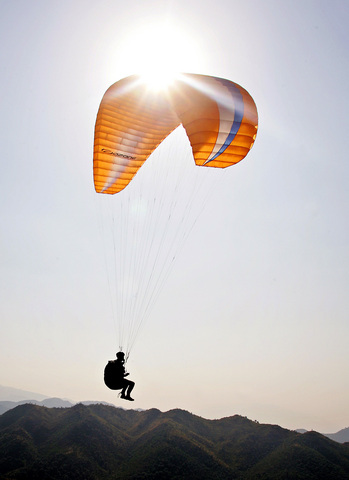For Pakistan's new class of affluent but bored young people, action sports like paragliding are providing a healthier outlet than fast cars and recreational substances.
"It is better than drugs and drag racing on city roads," says local pioneer Sajjad Shah, 43, as he unloads gliders from his green Toyota Prado in the scenic northwestern village of Thipra.
Shah, one of the country's top pilots, says people often approach him and his friends when they fly in the Margalla Hills overlooking the capital Islamabad and beg to be taught how to paraglide.

PHOTOS: AFP
"Paragliding is not an expensive sport and for youths who destroy cars worth million of rupees in a night while racing it is no big deal for them," said Shah, who is also president of the Pakistan Association of Free Flying.
On a recent trip Shah and his fellow pilots make a steep 45-minute climb in this sub-Himalayan region then unpack the fabric wings, lay them on the ground and hook them to their harnesses.
One by one they stand facing the wind before the gliders lift them into the sky. Minutes later the pilots land in the cornfields below as schoolchildren in ragged clothes gather to greet them.

"Only a paraglider pilot knows why birds sing," said fellow pilot Abdul Jabbar Bhatti after touching down.
Despite fears of terrorism since Sept. 11 that have sent tourist numbers plummeting, top paragliders have recently visited the flying school run by Shah and friends at Thirpa.
One top flyer, Leroy Westerkamp of the Netherlands, this year set a new world record for gaining height while paragliding, ascending 4,526m to reach an altitude of 7,685m in Pakistan's northern Hunza district.

The Dutchman will return next year to fly over the 8,611m K2, the world's second highest mountain, in a paraglider.
The Pakistan Association of Free Flying plans to hold an international paragliding festival next year at Chajian near Islamabad.
The only setback to the sport has been the government ban on paragliding near Islamabad for security reasons, which was introduced in April.
"Paragliding has a great potential to promote tourism in Pakistan and we have sponsored paragliding events" during the famous Shandur polo festival in northwest Pakistan, says Jahangir Khan, deputy chief of Pakistan Tourism Development.
Pakistan's economy has also soared in recent years. Growth was 8.4 percent in from 2004 to last year, its highest in two decades, and although it dipped to 6.6 percent officials say the outlook is still good.
Analysts say the booming economy has enhanced the buying power of the middle-classes of the 150 million population, while those with old money are living luxuriously.
Pakistan's first Rolls-Royce showroom opened in Lahore this week and other luxury carmakers including Porsche, BMW and Mercedes-Benz are branching out.
"We have sold 50 Porches during the past 10 months and the demand is still rising," said Taimur Malik, sales manager of Autotechnik Private Limited, which opened Pakistan's first Porsche facility last year, also in Lahore.
"Pakistan is a booming automobile market and that is why Porsche itself selected it to sell their high-end exclusive cars," he said.
"A loose monetary policy and increased remittances from overseas have benefited the middle- and upper-middle class over the past five or six years," said Mohammed Sohail, an economic analyst.
"The resultant boom has brought further riches to the already rich," Sohail said.
Instant gratification is hard to come by in Pakistan and here buyers have to wait months for their luxury cars — and often for lesser models — despite paying in advance.
And with a ban on the public consumption of alcohol meaning that organized nightlife is almost non-existent in Pakistan, young people find themselves similarly frustrated.
Extreme sports could provide them with an outlet, hopes paraglider Shah.
"It provides more of a thrill than riding a motorbike with its front wheel in the air," he said.

June 23 to June 29 After capturing the walled city of Hsinchu on June 22, 1895, the Japanese hoped to quickly push south and seize control of Taiwan’s entire west coast — but their advance was stalled for more than a month. Not only did local Hakka fighters continue to cause them headaches, resistance forces even attempted to retake the city three times. “We had planned to occupy Anping (Tainan) and Takao (Kaohsiung) as soon as possible, but ever since we took Hsinchu, nearby bandits proclaiming to be ‘righteous people’ (義民) have been destroying train tracks and electrical cables, and gathering in villages

Dr. Y. Tony Yang, Associate Dean of Health Policy and Population Science at George Washington University, argued last week in a piece for the Taipei Times about former president Ma Ying-jeou (馬英九) leading a student delegation to the People’s Republic of China (PRC) that, “The real question is not whether Ma’s visit helps or hurts Taiwan — it is why Taiwan lacks a sophisticated, multi-track approach to one of the most complex geopolitical relationships in the world” (“Ma’s Visit, DPP’s Blind Spot,” June 18, page 8). Yang contends that the Democratic Progressive Party (DPP) has a blind spot: “By treating any

Swooping low over the banks of a Nile River tributary, an aid flight run by retired American military officers released a stream of food-stuffed sacks over a town emptied by fighting in South Sudan, a country wracked by conflict. Last week’s air drop was the latest in a controversial development — private contracting firms led by former US intelligence officers and military veterans delivering aid to some of the world’s deadliest conflict zones, in operations organized with governments that are combatants in the conflicts. The moves are roiling the global aid community, which warns of a more militarized, politicized and profit-seeking trend

This year will go down in the history books. Taiwan faces enormous turmoil and uncertainty in the coming months. Which political parties are in a good position to handle big changes? All of the main parties are beset with challenges. Taking stock, this column examined the Taiwan People’s Party (TPP) (“Huang Kuo-chang’s choking the life out of the TPP,” May 28, page 12), the Democratic Progressive Party (DPP) (“Challenges amid choppy waters for the DPP,” June 14, page 12) and the Chinese Nationalist Party (KMT) (“KMT struggles to seize opportunities as ‘interesting times’ loom,” June 20, page 11). Times like these can